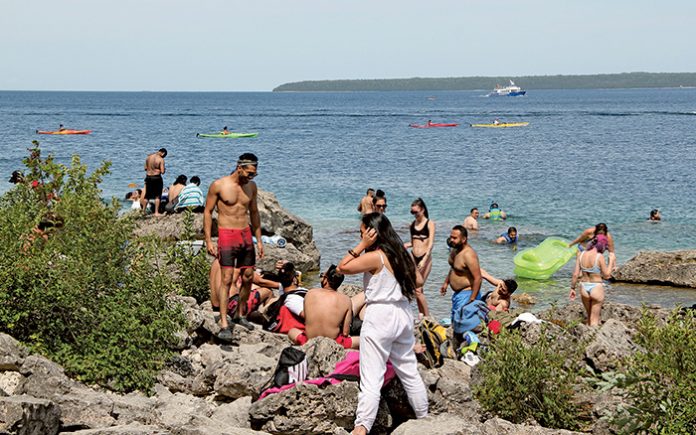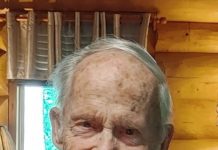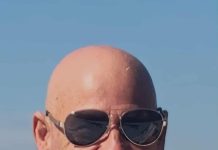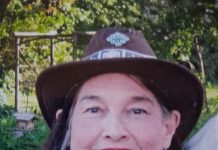
In the Age of Social Media, a Picture is No Longer Worth a Thousand Words
By John Francis
Northern Bruce Peninsula has seen a dramatic increase in tourism over the past few decades. The overcrowding and annoyance in recent years have made it much more noticeable, but the pattern of rapid growth dates back to the 1960s.
That growth has not been consistent across the board — in fact it has been quite uneven.
Until recently, Lion’s Head’s tourist season consisted mainly of cottagers. They came into town for food, services, hardware, supplies for the cottage, plus ice cream and of course, the beach. It was a comfortable, same-people-every-year kind of atmosphere and the merchants thrived. The recent flood of daytrippers and overnighters has been a bit of a shock.
Tobermory had some cottagers, sure, but the largest tourism “input” used to be ferry traffic. In the 1970s the ferry was frequently booked a couple of days in advance and those who failed to plan ahead (not a new phenomenon!) would be forced to find a place to stay for a day or two until they could get on the boat and continue their trip. The motels and restaurants were frantically busy for six or seven weeks every year — from the second weekend in July to the day the CNE opened in Toronto in mid-August.
And on the Monday of Labour Day Weekend, it was as if somebody pulled a giant plug at Wiarton — all the tourists drained out of the peninsula in a few hours and we were suddenly left to ourselves again until May.
A lot of that ferry traffic was driven by “Circle Tour” marketing campaigns. There was the Georgian Bay Circle Tour and the (international!) Lake Huron Circle Tour.
The “Circle Tour” marketing ended in the 1970s, but the awareness of circle tours remained for years, replaced eventually (in Michigan at least) by a “don’t go to Canada — the GST makes everything too expensive” campaign and a lot of deliberate misinformation about not being able to get emergency care at Canada’s “socialist” hospitals.
Ferry traffic fell off steadily starting in the late 1980s. You can blame the “four-laning” of Highway 69 for that if you like, but I would suggest that the lack of circle tour marketing was also a factor.
As this was happening though, a different pattern was developing. People were coming to Tobermory as a destination, spending their whole vacation here; increasingly, they were renting a cottage. I don’t think this was driven by advertising so much as word of mouth.
I would suggest that it works better to think about this in terms of “buzz” rather than in strictly marketing terms. (For example, the negative buzz of the “socialized medicine” scare was driven by American talk radio, not advertising.)
Take the CNE (Canadian National Exhibition) for example. When I was a kid in Toronto, the “Ex” was the biggest thing in Canada. Bigger than the Stanley Cup. Attendance used to get up over 200,000 on Saturdays. The CNE didn’t need advertising or marketing — it was already “viral”. The newspapers eagerly awaited opening day and they all printed yesterday’s CNE attendance beside the masthead on page one. The radio stations talked about it all day. People on the street talked about it every day.
The CNE probably started to go downhill 60-odd years ago but nobody noticed for awhile — even if it wasn’t as good as last year, it was still more exciting than anything else. But it got gradually less exciting every year to the point that, for the last 30 years or so, nobody has thought about it at all.
The concept of “buzz” offers an excellent lens for talking about the number of visitors at our local National Parks. The parks haven’t had a marketing budget for about 20 years, but the numbers kept going up every year despite that.
The internet has really accelerated both the speed and the impact of “buzz”. People are bombarded with hundreds or thousands of images every day; those images are probably more influential than “word of mouth”. Attractive images quickly find their way to hundreds of thousands of screens and suddenly, huge numbers of people want to have that same experience. Some people just want a “one-and-done” selfie; others want to bring a grill and a cooler to make a day of it. But either way, they seek out “celebrity locations”.
I first noticed this about 20 years ago when a pre-Facebook website called “localsknow” posted a gorgeous picture of Indian Head Cove (aka the Grotto) taken with a fisheye lens and a polarizing filter. It turned the Grotto into a “must-see” location — a celebrity. Within a couple of years, it was getting overcrowded and people had to be turned away on weekends. A few more years and they were turning people away daily by mid-morning.
But Parks Canada’s reservation system has solved that problem. The number of turnaways is steadily decreasing — understanding of that reservation system is now part of the “buzz”.
Lion’s Head lookout, Little Cove and Mermaid’s Cove became celebrity locations in recent years — all without any marketing whatsoever — and the crowding at all three became ridiculous. MNBP tried to control the crowds with parking regulations.
This looked like a failed strategy at first when, in 2020, they eliminated roadside parking on Little Cove Road in mid-season, only to have people park on Warner Bay Road and walk several kilometres to Little Cove. But that problem did not recur in 2021.
The situation at Lion’s Head lookout is also complicated but seems to be heading in the right direction. Eliminating visitor parking on Moore Street solved the safety problem on that street; the Parkpass reservation system is working well for the McCurdy Street parking lot, while generating a sizeable whack of revenue for the municipality. We’ll find out this summer if the people who didn’t get reservations are willing to walk an extra kilometre to get to the trailhead.
The response was much more immediate when MNBP eliminated visitor parking on Grant Watson Drive (access for Mermaid’s Cove). This was done in time for the beginning of the 2021 season and the crowding problem simply disappeared.
It used to be that concepts and stories lasted quite a while in people’s awareness because they weren’t constantly being pushed out by newer ones. People talked about circle tours long after the marketing stopped; people expected “The Ex” to be wonderful long after it wasn’t.
But in 2022 I would suggest we have a new pattern here, driven by a constantly refreshed barrage of images on Facebook, TikTok, Instagram, Snapchat. Crowding problems aren’t being driven by advertising and marketing — or even last year’s Youtube videos — they are being driven by that barrage of “now” images.
They used to say a picture is worth a thousand words. But that was based on scarcity — when there weren’t all that many pictures or printed words in daily life. I reframed that as “a picture will make them read the thousand words”, but that’s not true anymore either. A good picture will make them read twenty words, tops.
I am guessing that, for better or for worse, people are going to go where the most recent barrage of images directs them.
But there is a bright side to this. It appears that we can successfully solve overcrowding issues by regulating parking. The evidence suggests that this works best when implemented before a season begins so that the barrage of images never really gets started.
Is there some way we can insert our own messages into that barrage? If we make it clever and cheeky and funny? And short — think 20 words.
Any thoughts?












